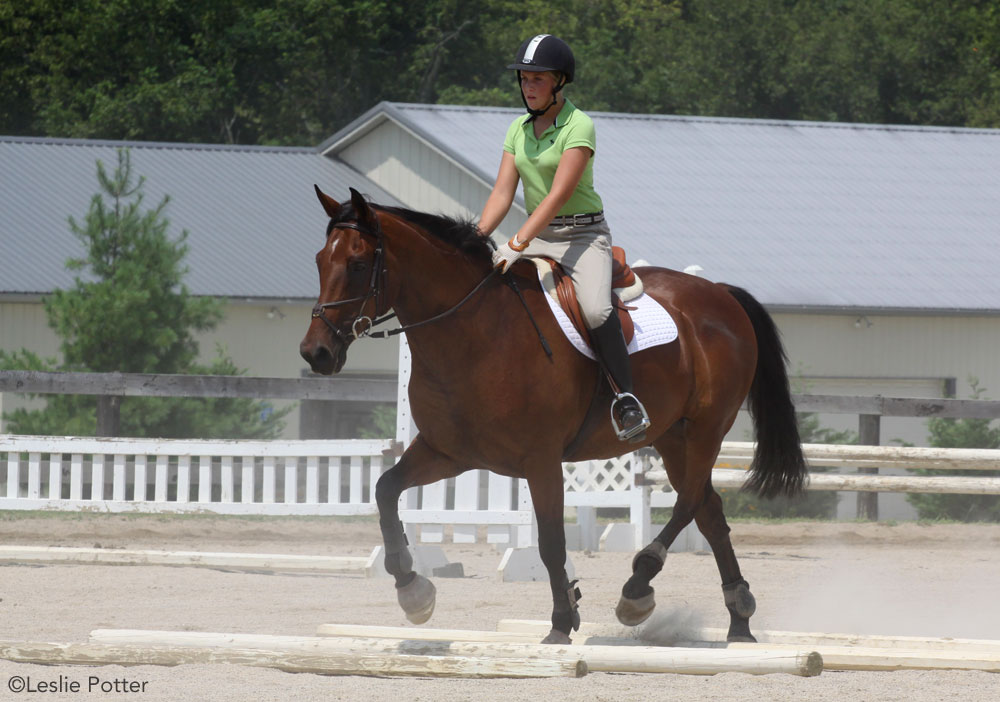
It’s not safe to jump by yourself in the arena, so, if no one is around to watch you, working over poles is a way to keep your horse tuned up without actually popping over any fences.
The poles you use on the ground should be solid and heavy so they won’t roll or split if your horse kicks them. You can make your own poles out of 8-foot landscaping poles. The poles will be easier for your horse to see if they are painted white and some other dark color like red, green or black. Avoid using plastic plumbing pipes as poles as these may shatter if your horse steps on them.
Here are a few easy-to-set-up pole exercises that you can do with your favorite horse.
Single Poles
Place several poles randomly around the arena and incorporate them into your flatwork sessions. Start by walking over the poles and then move on to the trot and canter. Work the poles into your circles, serpentines and figure-eights. Don’t get into jumping position as you approach the pole; if you’re trotting, continue rising, and if you’re cantering, keep your seat lightly in the saddle.
If your horse is young or green and hasn’t seen a pole before, be prepared for him to jump 10 feet over it. Some horses find poles very scary at first! Just continue walking or trotting over the same pole until your horse gets bored and steps over it properly instead of leaping into the air. Then move on to the next pole.
Always aim for the middle of the pole and try to keep your horse’s pace and rhythm the same as he approaches and travels over the pole. Keep your reins even, your contact firm and your legs touching his sides to urge him to move forward. Don’t allow your horse wiggle around in front of the pole or run out.
Trotting Poles
Set up a line of five poles and place them parallel to each other. For a horse, set the poles about 4 ½ feet to 5 feet apart. For a pony, set the poles about 3 ½ feet to 4 feet apart. You may have to adjust these distances if your horse trips up every time he goes down the line. After one or two goes, he should figure out where to put his feet if the poles are properly spaced. If he’s having trouble, hop off and make the distances smaller or bigger depending on how big a stride your trusty mount has.
Ask your horse to trot around the arena at a steady, active pace before you approach the line of poles. He should have a spring in his step; this is known in the horsey world as “impulsion.” If your horse is poking along, he may trip over the poles. Squeeze him with your lower legs every time you rise out of the saddle to encourage him forward at an energetic pace.
Approach the poles with plenty of room; don’t just yank your horse into them at the last second. Steer him toward the middle of the poles and push your hands forward slightly so you don’t pull him in the mouth. You can rise to the trot over the poles or lift your seat slightly out of the saddle and get into a “half seat” to get off his back and allow him to really work his back muscles.
Some horses can be lazy and slow down the second they cross over the last pole, so ask your horse to keep trotting around the arena.
Poles in a Circle
Set up four poles which touch the outside of a 20-meter circle (as shown on the diagram). Walk over the poles at first. Think about bending your horse slightly to the inside. Keep your inside leg at the girth, your outside leg slightly behind the girth, your inside hand slightly away from his neck and your outside hand just brushing his neck. Ask your horse to walk forward at a good pace. Once you walk over one pole, look to the next one. Ask your horse for the inside bend all around the circle.
Remember to do the circle exercise in both directions. Most horses are stiff on one side and need to be worked consistently in both directions to become more supple.
Once your horse has walked the circle in both directions, try it at the trot. Don’t let your horse sneakily drift outside the pole to avoid trotting over them. Keep the inside bend by squeezing on the inside rein and keeping him on the circle with your outside leg.
You may find it difficult to canter the poles at first. Those poles will race up pretty quickly! The first circle or two may be a bit ugly with your horse jumping the poles or tripping, but if you ask him for a collected, bouncy canter, he should be able to figure it eventually and canter over the poles in stride.
Canter Poles
Set up three poles in a row, 9 feet apart. These are called canter poles, and even though this exercise seems like it should be easy, for some reason most horses find it very difficult at first! Some horses try to jump two poles or once or they just crash through the whole exercise. You’ll have to practice to get it right.
Pick up a nice, bouncy canter before you head for the poles. Give a tiny half halt to balance your horse a few strides in front of the exercise, then soften with your hands so you don’t yank him in the mouth if he jumps big or gets the exercise wrong.
Remember to do this exercise from both directions.





